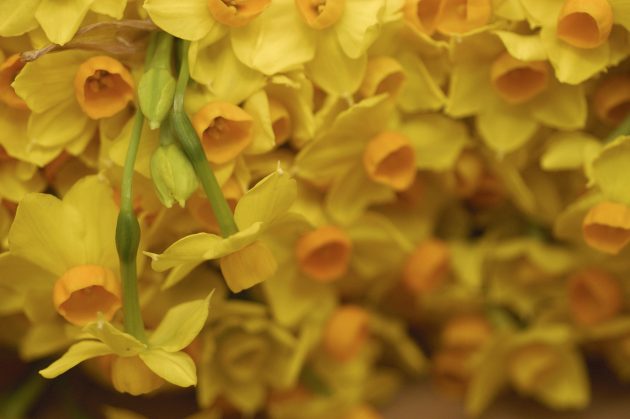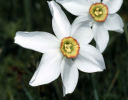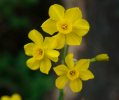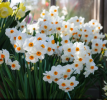Often planted to ‘cheer up’ the landscape before the trees come into leaf, daffodils make for striking floral displays but narcissi are the real stars of spring, says Ursula Buchan
Spring colour
Before you settle down to read this feature about daffodils and narcissi, be sure to take a look at some more colourful spring content from The Field. There’s Johnny Scott on Eostre and the origins of our Easter traditions, while Madeleine Silver picks out some of the most tempting Easter eggs.
Are there just too many daffodils in the world? Every March, I ask myself this question as I drive down country lanes near my home in the Midlands. Here and there, the grass verges are punctured by clumps of shouty, yolk-yellow ‘Golden Harvest’, ‘Dutch Master’ or ‘King Alfred’ daffodils. These, sadly, will flower every March until the crack of doom. And my heart sinks lower with every cheery yellow wave I pass. No doubt these bulbs were planted with the best of intentions. But, for me, their in-your-face obviousness detracts from the quiet beauty of smoke-white blackthorn and burgeoning fresh-green hawthorn leaves.
Those bulbs that have been deliberately planted, rather than dumped from nearby gardens, are to ‘cheer up’ the landscape before trees come into leaf. Perhaps also to encourage the bees. The importance of nectar for native bumble and solitary bees early in the year cannot be overstated. However, tall, long-trumpeted daffodil varieties aren’t what’s required. Breeding for height and floral impact has often been at the expense of nectar and pollen. The popular double-flowering daffodils, such as ‘Golden Ducat’, are useless. It is helpful to know that varieties of the Narcissus genus that have a trumpet (corona) longer than the width of their tepals (petal-like sepals) are traditionally called ‘daffodils’. Those with coronas or cups as short or shorter are known as ‘narcissi’.
Daffodils and their trumpets
Far better for the pollinators are single flowered Narcissus species, including our native Narcissus pseudonarcissus. (Buy bulbs below.) This is the flower so famously encountered by William Wordsworth and his sister on a walk close to Ullswater. Dorothy recorded in her journal: “I never saw daffodils so beautiful. They grew among the mossy stones about and above them; some rested their heads upon these stones, as on a pillow, for weariness, and the rest tossed and reeled and danced, and seemed as if they verily laughed with the wind that blew upon them over the lake; they looked so gay, ever glancing, ever changing.” For me, that description beats “I wandered lonely as a cloud” any day.
I also have a soft spot for the nonnative, scented N poeticus, N jonquilla and N tazetta. These are species narcissi collected long ago in the wild, which have not been so much ‘improved’ by breeding. I recommend an impressive form of poeticus called ‘Actaea’, which has larger flowers than the species. ‘Pipit’ and ‘Baby Moon’ are good selections of the jonquil, and ‘Geranium’ a fine form of N tazetta. But none of these cultivated varieties has strayed far from its origins.

Clumps of narcissi and daffodils add welcome colour when gardens, for the most part, can still feel a little drab
Delicate flowers with jaw-cracking names
A few years ago, our parish council decided on a bulb-planting campaign ‘to brighten up’ a triangle of green grass in the village. I persuaded them to plant the native ‘Lent lily’, N pseudonarcissus, subspecies pseudonarcissus, and the ‘Tenby’, N pseudonarcissus, ssp obvallaris. Despite the jaw-cracking names, these are delicately pretty, single-flowered, 30cm-high narcissi with pale-yellow tepals and golden trumpets of the same length. The parish council requested that the leaves be left to die down naturally and the council lawnmower drivers seem to respect that, for the numbers are gradually increasing.
I have nothing against highly bred daffodils in gardens or in public parks, where every planting is ‘unnatural’. I do see the appeal of the big ’uns: their range of colour can make for striking displays. Although I don’t plant large, trumpeted daffodils in my garden, I have left some ‘Golden Harvest’ that I inherited from my predecessor, since they are ideal for Mothering Sunday bouquets. But I prefer to plant the smaller narcissi, as well as crocuses, ipheions, scillas, puschkinia and the pink-flowering, shrubby daphnes, to provide colour in early spring.
There can never be enough narcissi or daffodils in the world
All species narcissi, except the shortest, are good for ‘naturalising’ in grass. I grow the late-flowering, 40cm-tall poeticus, also called the ‘Pheasant’s Eye’ narcissus, among the fruit trees in the hedge-bound space that I grandly call ‘The Orchard’. For 20 years, in late April and early May, elegant, sweetly scented flowers have waved in the spring breeze. The flowers have white petals and short, yellow cups, edged with orange-red. They vaguely resemble the red-rimmed, yellow eyes of cock pheasants. To my mind, there can never, ever be enough of these narcissi in the world.
If you enjoyed this article, find more gardening features from The Field. Find out how to create an insect-friendly garden . New to gardening? Read our guide to the best books and sources of advice for novice gardeners.
Shopping list









